新的四元哈达玛矩阵族
IF 1.2
2区 数学
Q3 COMPUTER SCIENCE, THEORY & METHODS
引用次数: 0
摘要
阶数为 n 的四元哈达玛矩阵(QHM)是一个在四元中具有非零条目的 \(n/times n\) 矩阵 H,使得 \(HH^*=nI_n\) ,其中 \(I_n\) 和 \(H^*\) 分别表示 H 的同位矩阵和共轭变换。如果一个 QHM 的第一行和第一列的所有条目都是 1,那么它就是去相的,如果它的条目产生一个非交换群,那么它就是非交换的。我们工作的目的是提供无限多(非交换去相位)QHM 的新构造;Farkas 等人(IEEE Trans Inform Theory 69(6):3814-3824, 2023)利用这些矩阵产生了互不偏倚的测量结果。本文章由计算机程序翻译,如有差异,请以英文原文为准。
New families of quaternionic Hadamard matrices
A quaternionic Hadamard matrix (QHM) of order n is an \(n\times n\) matrix H with non-zero entries in the quaternions such that \(HH^*=nI_n\), where \(I_n\) and \(H^*\) denote the identity matrix and the conjugate-transpose of H, respectively. A QHM is dephased if all the entries in its first row and first column are 1, and it is non-commutative if its entries generate a non-commutative group. The aim of our work is to provide new constructions of infinitely many (non-commutative dephased) QHMs; such matrices are used by Farkas et al. (IEEE Trans Inform Theory 69(6):3814–3824, 2023) to produce mutually unbiased measurements.
求助全文
通过发布文献求助,成功后即可免费获取论文全文。
去求助
来源期刊

Designs, Codes and Cryptography
工程技术-计算机:理论方法
CiteScore
2.80
自引率
12.50%
发文量
157
审稿时长
16.5 months
期刊介绍:
Designs, Codes and Cryptography is an archival peer-reviewed technical journal publishing original research papers in the designated areas. There is a great deal of activity in design theory, coding theory and cryptography, including a substantial amount of research which brings together more than one of the subjects. While many journals exist for each of the individual areas, few encourage the interaction of the disciplines.
The journal was founded to meet the needs of mathematicians, engineers and computer scientists working in these areas, whose interests extend beyond the bounds of any one of the individual disciplines. The journal provides a forum for high quality research in its three areas, with papers touching more than one of the areas especially welcome.
The journal also considers high quality submissions in the closely related areas of finite fields and finite geometries, which provide important tools for both the construction and the actual application of designs, codes and cryptographic systems. In particular, it includes (mostly theoretical) papers on computational aspects of finite fields. It also considers topics in sequence design, which frequently admit equivalent formulations in the journal’s main areas.
Designs, Codes and Cryptography is mathematically oriented, emphasizing the algebraic and geometric aspects of the areas it covers. The journal considers high quality papers of both a theoretical and a practical nature, provided they contain a substantial amount of mathematics.
 求助内容:
求助内容: 应助结果提醒方式:
应助结果提醒方式:


